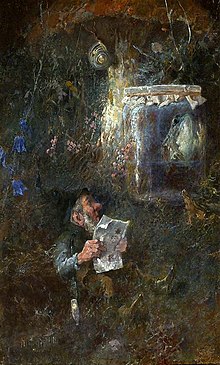
Back Kabouter Afrikaans Гном Byelorussian Гном BE-X-OLD Гном Bulgarian Gnom BS Gnom Catalan Gnóm Czech Krôsniã CSB Gnom German Gnomo Esperanto
 Gnom mit Zeitung und Tabakspfeife (English: Gnome with newspaper and tobacco pipe) by Heinrich Schlitt (1923) | |
| Grouping | Diminutive spirit |
|---|---|
| Folklore | Renaissance |
| First attested | 16th century |
A gnome (/noʊm/[1]) is a mythological creature and diminutive spirit in Renaissance magic and alchemy, introduced by Paracelsus in the 16th century and widely adopted by authors including those of modern fantasy literature. Typically small humanoids who live underground, gnome characteristics are reinterpreted to suit various storytellers and artists.[2]
Paracelsus's gnome is recognized to have derived from the German miner's legend about Bergmännlein or dæmon metallicus "metallurgical or mineralogical demons" according to Georg Agricola (1530), also called virunculus montanos (literal Latinization of Bergmännlein, = "mountain manikin") by Agriocola in a later work (1549), and described by other names such as cobeli (sing. cobelus; Latinization of German Kobel). Agricola recorded that according to the legends of this profession, these mining spirits as miming and laughing pranksters that sometimes threw pebbles at miners, but could also reward them by depositing a rich vein of silver ore.
Paracelsus also called his gnomes occasionally by these names (Bergmännlein, etc.) in the German publications of his work (1567). Paracelsus claimed they measured 2 spans (18 inches) in height, whereas Agricola stated them to be 3 dodrans (3 spans, 27 inches) tall.
Lawn ornaments crafted as gnomes were introduced during the 19th century, growing in popularity during the 20th century as garden gnomes.
The name of the element cobalt descends from kobelt, 16th century German miners' name for an unwanted ore (cobalt-zinc ore, or possibly the noxious cobaltite and smaltite), thought to be the result of mischief perpetrated by the gnome kobel[a](cf. § cobalt ore). This kobel is technically not the same as kobold, but there is confusion or conflation between them.
Cite error: There are <ref group=lower-alpha> tags or {{efn}} templates on this page, but the references will not show without a {{reflist|group=lower-alpha}} template or {{notelist}} template (see the help page).
© MMXXIII Rich X Search. We shall prevail. All rights reserved. Rich X Search